Background: why DEEPRED and REDPEAK?
Peaks in electricity demand bring about significantly negative environmental and economic impacts. In a de-carbonised future, peaks will be an issue due to the integration of intermittent renewables in the supply mix as well as electric vehicles and electric heat pumps. Not enough is known about residential peak demand and what levels of flexibility might be available. For this reason, the REDPEAK project was set up.

The overall aim of REDPEAK is to analyse the variation in sequences of activities taking place at times of peak electricity demand and identify users who might provide flexibility for peak shifting intervention.
Time of Use (ToU) tariffs offer significant potential benefits to the system by enabling responsive electricity demand and reducing peaks. For example, ToU could reduce the need for new generation and network capacity. The impact of more cost-reflective pricing will vary between consumers where those who consume electricity at more expensive peak periods, and who are unable to change their consumption patterns, could end up paying significantly more. Because little is known about the effects of dynamic tariffs on different socio-demographic groups, the DEEPRED project was set up to address this gap in knowledge.

The objectives of DEEPRED consist of analysing the distributional effects of ToU tariffs with a view to identify clusters of users which might significantly benefit or be disadvantaged through the provision of demand flexibility.
What we have been up to
These first two years of REDPEAK and DEEPRED projects have involved mainly of activities in terms of analysing; writing; and presenting.
Analysing
We have analysed peaks in residential from many different perspectives. The main thing we were interested in was to understand the activities that constitute peaks.
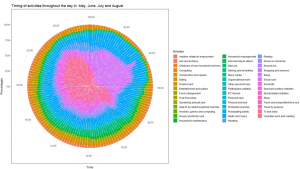
The hypnotic image above above shows the timing of activities around the 24 hours of the day in spring/summer months.
For instance, we looked at what peaks would look like if some of the sequences of activities which constitute peaks were broken.
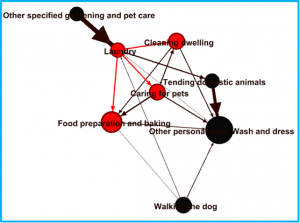
As another example, the figure above shows how networks of activities would change if we took away laundry from existing sequences of activities. This is a way of thinking of flexibility intervention not only in terms of technology and price, but also if work arrangements changed.

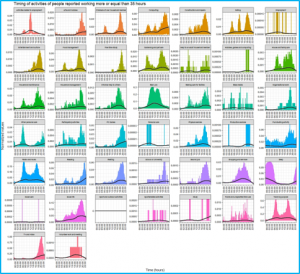
With this in mind, we compared for instance how peaks change for people who have longer working hours (more than 35 hours per week, left) compared with those who work fewer than 35 hours, right).
In terms of analysis of impacts of ToU, we looked both at differences across socio-demographic groups and clusters.
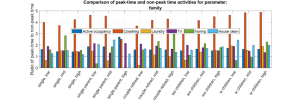
For example, we estimated the peak to off-peak ratios of active occupancy and different activities in order to understand which households will be advantaged or disadvantaged from the introduction of ToU. Single parents on a low income and households with children on a low income might be particularly disadvantaged from ToU as they tend to do more things in the home at peak time compared with off-peak periods.
Writing
Journal articles
Conference papers
Yunusov, T., Lorincz, M. J. and Torriti, J. (2018) Role of household activities in peak electricity demand and distributional effects of Time-of-Use tariffs. In: British Institute of Energy Economics 2018, 18-19 September 2018, Oxford, UK.
McKenna, R., Kleinebrahm, M., Yunusov, T., Lorincz, M. J. and Torriti, J. (2018) Exploring socioeconomic and temporal characteristics of British and German residential energy demand. In: British Institute of Energy Economics 2018, 18-19 September 2018, Oxford, UK.
Cardoso, C. A. and Torriti, J. (2018) Business participation in demand side response: a review of potential barriers. In: British Institute of Energy Economics 2018, 18-19 September 2018, Oxford, UK.
Reports
Speaking
We have presented our work to both academic and non-academic audiences.
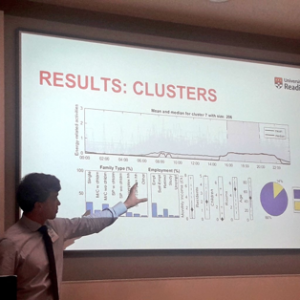
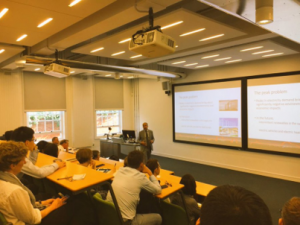
- November 2019 Oxford Talks, A Win-Win for everyone? Demand-side Flexibility and People’s Activities, Oxford
- August 2019 Exploring the Temporal Ordering, Sequencing and Synchronization of British Residential Energy Demand, In: ESA Conference Proceedings. Manchester.
- June 2019 Exploratory analysis of family-related activities during peak electricity periods. In: ECEEE Conference Proceedings, Belambra Presqu’île de Giens, France.
- May 2019 Sooner or later: Shifting the Timing of Electricity Demand – Jacopo Torriti Inaugural Lecture
- November 2018 Oxford Institute for Energy Studies workshop, Flexibility in residential electricity demand: focus on people’s activities, Oxford.
- September 2018 The effect of working status in structuring peak electricity demand. In: Behave Conference Proceedings, Zurich, Switzerland.
- September 2017 TU Wien workshop, People’s activities and residential electricity demand: A time use approach, Vienna.
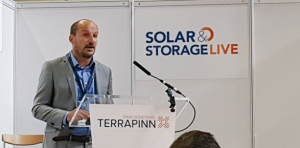


- September 2019 Solar & Storage Live, Consumer Flexibility: Unpacking the Level of Responsiveness Available in the Residential Sector, Birmingham.#
- July 2019 Ofgem Seminar Series, Household activities and distributional effects of Time-of-Use tariffs, London.
- June 2019 Scottish Southern Electricity Networks Conference, Core capacity SAVE data & social science literature review, London.
- April 2019 Citizens Advice Annual Conference, Power to the people, London.
- May 2019. Green Alliance Roundtable, London: ‘Demand Flexibility’.
- October 2018 International Energy Agency workshop, Research on demand-side flexibility: residential and non-residential sectors, London.
In February 2019 we organised a workshop in Westminster which was attended by individuals from 35 different organisations representing energy Distribution System Operators, suppliers, policymakers, civil society and other universities.

